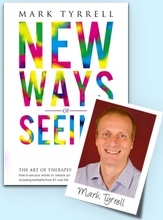
Using hypnosis, we can help orientate a client into a sense of a better future.
Caroline cried bitterly into her sodden tissue.
I heard a tale of heartbreak, abuse, betrayal, bullying, and deception. Her parents had been mistreating her physically and verbally “forever”. Her first husband, whom she’d loved even though he was “nasty”, had died of a drug overdose. Her second husband had bullied her almost to the point of torture.
Caroline gingerly showed me a still-angry scar on the back of her hand where he’d burned her with his cigarette. Eventually, after he’d tried to kill her, she’d called the police. They took him away immediately, because he was attacking her even as they arrived. It was then that she finally made her escape.
Still young, Caroline made a new start in a new town. Her ex-husband is now in prison for another violent crime against a man in a nightclub.
Now Caroline wanted help to overcome a sense of despair about her life in general. I used the Rewind technique to help her overcome the most horrific haunting memories, which would still pounce on her now and then. And we worked on her painful past in other ways, too.
But once we’d helped her feel better about her past, once the nightmares and the faulty pattern matching of flashbacks had subsided, it was her future I really wanted to help her with. After all, that is where she was headed.
For Caroline, any sense of a future life that wasn’t just more of the same life would be a big and positive step. But her experiences had left her unable to even see a future, let alone a better one.
Fortunately, hypnosis can be a great way to instil a sense of hope.
Hypnotic age progression
Using hypnosis, we can help orientate a client into the distant past, as with regression. We can help orientate them into a different time and place, as when we have them reaccess the wonderful feelings of being on a blissful vacation despite, in reality, being here with us in our office. And we can also orientate them into a sense of a better future.
So I might suggest to someone looking to become slimmer that they take a little preview of a future in which they are literally lighter on their feet, can begin to choose somewhat different clothes to wear, and so forth. In this way we begin to build a template of possibility for the mind.
Clear, positive instructions
The brain needs a clear sense of where we need to go, not just where we don’t want to be.
If you’re lost in a strange city and you ask someone for directions, you could tell them all the places you don’t want to go or why you want to be somewhere different from where you currently are. But sooner or later (I’m guessing sooner!), the local is going to want to know where in fact you do want to go in order to provide you with helpful instructions.
So too with clients. Once we’ve listened, helped with negative past conditioning, and built rapport with them, we may need to help them build a sense of a possible positive future.
Beyond creating a psychological template toward which a client can work both unconsciously and consciously (just as a physical placebo creates a biological blueprint for the mind and body to progress toward), hypnotic age progression can provide many other advantages in therapy. For example…
Age progression can test out a new behaviour
In order to find out how appropriate a new behaviour is going to feel, we can age-progress to a time when the changes have occurred and ask the person how happy they are with those changes. Age-progressing is a way of testing out whether changes are going to be appropriate or beneficial for the individual. The jargon for this is ‘ecological testing’.
One client, through hypnotic progression, experienced life as a single man after divorcing his wife to ‘test out’ the new way of living. Afterwards he told me he had decided not to seek a divorce, as life as a bachelor “wasn’t all it was cracked up to be!” During hypnosis, his unconscious mind had shown him the negatives as well as the positives of the decision to divorce.
And sometimes we can do something amazing.
Age progression can show us the solution from a future perspective
Sometimes, if you become ‘stuck’ with someone in therapy, you can deeply hypnotize them and progress them to a time when the solution to a problem behaviour has been found. They can then describe to you just how it was that they got better. Here’s a case in point:
I hypnotized a client and age-progressed her to a time when she no longer suffered from anxiety and depression. When, during that trance, I asked how she had overcome her feelings of anxiety and depression, she said that she had stopped visiting her mother every week and instead visited her every four weeks “on my own terms”.
This was interesting, as she hadn’t discussed this at all outside of hypnosis.
She went on to say that this let her feel more in control of her life and brought the relationship with her mother onto “a more equal footing.”
When she came out of trance, this woman had amnesia for the age progression on a conscious level, but of course a part of her was aware of the experience.
I asked her whether she felt she’d like to begin to see her mother a little less “so the quality of the visits could improve” and whether she would consider beginning to negotiate with her mother about the timing of the visits rather than be dictated to.
A month later, the woman reported feeling much less anxious and hopeless, and “better about everything!” She also reported that her relationship with her mother had in fact improved.
More prosaically but no less usefully, we can also…
Show consequences of behaviour by age progression
Some symptomatic trance states are very immediate, letting realistic concepts of the past and future slip away.
Addiction is one such emotional trance state. The focus becomes narrowed down to the immediate gratification of whatever is desired at the time: “I want it, and I want it now!”
This is why telling teenagers that smoking might kill them by the time they’re 50 (or some other infinitely remote age!) rarely does any good – because that time is not now! And now is what smoking, or drinking, or taking illicit drugs, or watching pornography is all about.
Addicted people are excellent at living in the present – perhaps as a way of forgetting their past or avoiding their future. But living in the present without a serious sense of consequences is a disaster. And I don’t just mean an intellectual appreciation of consequences.
In Charles Dickens’ novel A Christmas Carol, Ebenezer Scrooge is taken into the future by a phantom to experience the consequences of his present actions. Now the future is no longer just some abstract state, but a tangible reality.
He changes his ways after this ghostly therapy!
We can do this, too – in a less supernatural way, of course, but with results that are no less dramatic.
Future tense
A young alcoholic was brought in by his wife. His doctor had told him that if he continued drinking at the current rate he would die young, as his liver was already showing signs of severe damage. It was clear, however, that his drinking was more of an issue to his wife, who was also concerned about their two young children.
I hypnotized him and suggested he experience “having a few drinks” in his mind as he relaxed, which he seemed to enjoy. I then age-progressed him 5, then 10, and finally 15 years into a possible future if he continued to drink at the same rate.
During hypnosis, I asked him to notice how his body felt, to look in a mirror, and to notice where his family was and what he was doing in life. I asked him what it felt like to be inside a body that had been drinking so much for so long. He went pale and looked quite ill. He also looked a little frightened. I suggested that he could have a very real awareness of this reality every time he even thought about drinking in the present.
I then regressed him back to the present, before progressing him forward again by those same time periods if he continued to drink from here on out, but in moderation. Again he noticed what his life was like and what he was doing, but this time he looked much more healthy and happy. I suggested that the reality of this progression could expand in his daily life.
On reorientation, he came out of hypnosis very relaxed, albeit perhaps a little confused from all the time travel! His wife reported three months later that he was drinking very moderately and had found work.
He had not merely discussed the future but, on some level, lived it.
We can also use age progression to help someone see and hypnotically take the steps they need to achieve what they need to achieve in the future. But when helping clients feel future potential, there’s something we need to avoid.
Help them get there by helping them see how to get there
Just visualizing success without visualizing the steps needed to get there can actually make us less likely to reach our goals.1
If we merely progress someone to a sense of a successful life with, perhaps, money, adoration from others, and so forth, this may do little more than facilitate a sense of excitement without encouraging any real preparation.
But when we discuss with our clients the actionable steps they need to take in order to achieve what they want, then we can have them hypnotically see themselves carrying out these steps as well as seeing the results of the steps. This is important, yet it is sometimes missed by hypnotherapists.
So how can you use hypnotic age progression with your clients?
Step one: Use solution-focused questions and get specific
Age progression occurs, to some extent, whenever you use future-orientated questioning. We are building ‘templates’ for future behaviour. A person can learn to do things in a new, more effective and enjoyable way during age progression.
Before using hypnosis we can simply ask a client questions about a preferred future and let them paint and build up the reality of that future with their words. Though it may not seem it, this kind of conjecture can form the beginning of a deep hypnotic induction.
For example, I asked Caroline how she’d like to be in the future. Because she had, not surprisingly, developed a negative bias to her thinking over the years, she replied, “I don’t want to feel afraid and inferior all the time!”
Again, we must remember that it’s useless to ask for directions in a strange city by talking about the places you don’t want to visit! I asked her again, stating that I understood what she didn’t want – but what did she want?
“I want to feel peace, happiness, and self-respect!”
Now we were getting some small sense of a better future… but we needed more specifics.
“How will you know when you have more peace, happiness, and self-respect?” I asked. And for the first time, she told me something specific about her preferred future.
“It’s like… I’ll feel calmer and happier when I start painting again. I’ll have more self-respect when I don’t just agree with my mum when she criticizes me, but stand up for myself a little bit more.”
So we’d gone from the nebulous and vague “happiness” and “self-respect” to actual indicators of these states. Now we had the tools we needed to begin to create a hypnotic picture.
With this in mind, I began to use my language more artfully.
Step two: Use positive presuppositions
Now, rather than talk in terms of “what would it be like”, or “what might it be like”, I began to talk in terms of “what are you going to notice the most as you start to feel happier” and “who among your friends do you think will notice this change in you first” and “what do you imagine they will notice about you first as you begin to become happier and claim your rightful self-respect?”
So from might or could or would, we’ve shifted to will and are going to. We are implying more positive certainty, but subtly.
Caroline told me her friends will notice her smiling more, as she was, in her words, a “fun-loving person underneath”. She said they’ll see a bounce in her step. She’ll be more proactive socially and more excited about her job – which, she admitted, was interesting.
I noticed that now she was using positive presuppositions too. “They’ll see” and “I will” rather than “They’d see” or “I would”.
I asked her to, just for a few moments, experience mini-trance by closing her eyes and just imagining what her friends will see in her as though she were one of them. In this way she began to experience mini hypnosis, a way of ‘softening her up’ for deeper and longer trances.
So we’d gone from exploring what would be different to exploring what will be different, then actively noticing those positive changes in her from her friends’ perspectives during hypnosis.
Next we changed the tense again.
Be surgical with your language
Just as a surgeon must use a scalpel with millimetre precision, it is vitally important that we pay close attention to the way we use language.
Changing tense can facilitate the process of age progression. For example, “You can drift to a time when you will be comfortable when meeting new people. You can notice what you are doing and enjoy being so comfortable being introduced to them now.
As Caroline began to enjoy mini-trances, I had her talk to me in trance. I now used the present tense as we talked about the future.
- “What are you doing now that’s making you smile so much?”
- “Can you tell me what is different here in the future that is so positive?”
- “Who is noticing these changes in you the most?”
It didn’t take long for Caroline to begin to describe this future state in the present tense too. So we were really building a template for her unconscious mind to fulfil.
Next, we can use more structured hypnotic inductions to facilitate exploration of a preferred future.
Step three: Use a progressive ‘journey’ to mirror the passage of time
Caroline had told me she liked to walk in the countryside sometimes. So during hypnosis I suggested she take a gentle stroll into the future along a beautiful pathway. We might suggest our clients walk down some steps, where each step represents a week of time.
Sometimes I’ll suggest that the future them is already there enjoying that future, and can beckon and encourage them on into that better time. Caroline really seemed to enjoy that idea. She found herself feeling freer, happier, and inwardly lighter as she moved along this inner journey.
Sometimes I might ask a client to walk down a staircase and suggest that each landing or floor they reach is a specified time in the future. Eventually they reach a point in time, perhaps years or months or even just weeks into the future, at which they’ve made the changes they wanted.
At that point I will ask them to notice the improvements they had made at each point and to reflect on all the ways and steps they took to get to where they are “now”. We might ask them how they are meeting their primal needs here in the future.
I did all kinds of things therapeutically to help Caroline develop a meaningful and enjoyable life. But I know she really enjoyed the hypnosis and, as she put it, “exploring the future enjoyably”.
She also told me what she’d told a pessimistic friend: “Just because your past was a certain way it doesn’t mean your future has to be that way, you know.”
Caroline had come a long way.
How to Engage Your Client’s Imagination for Therapeutic Gain
As you’ll know if you’ve read Mark’s writings for any time, he uses hypnosis as an integral part of his work. This is because it can resolve certain issues much more easily, quickly, and deeply than other forms of psychotherapy. If you’d like to learn how to do this yourself, take a look at his online course Uncommon Hypnotherapy.
Notes:






